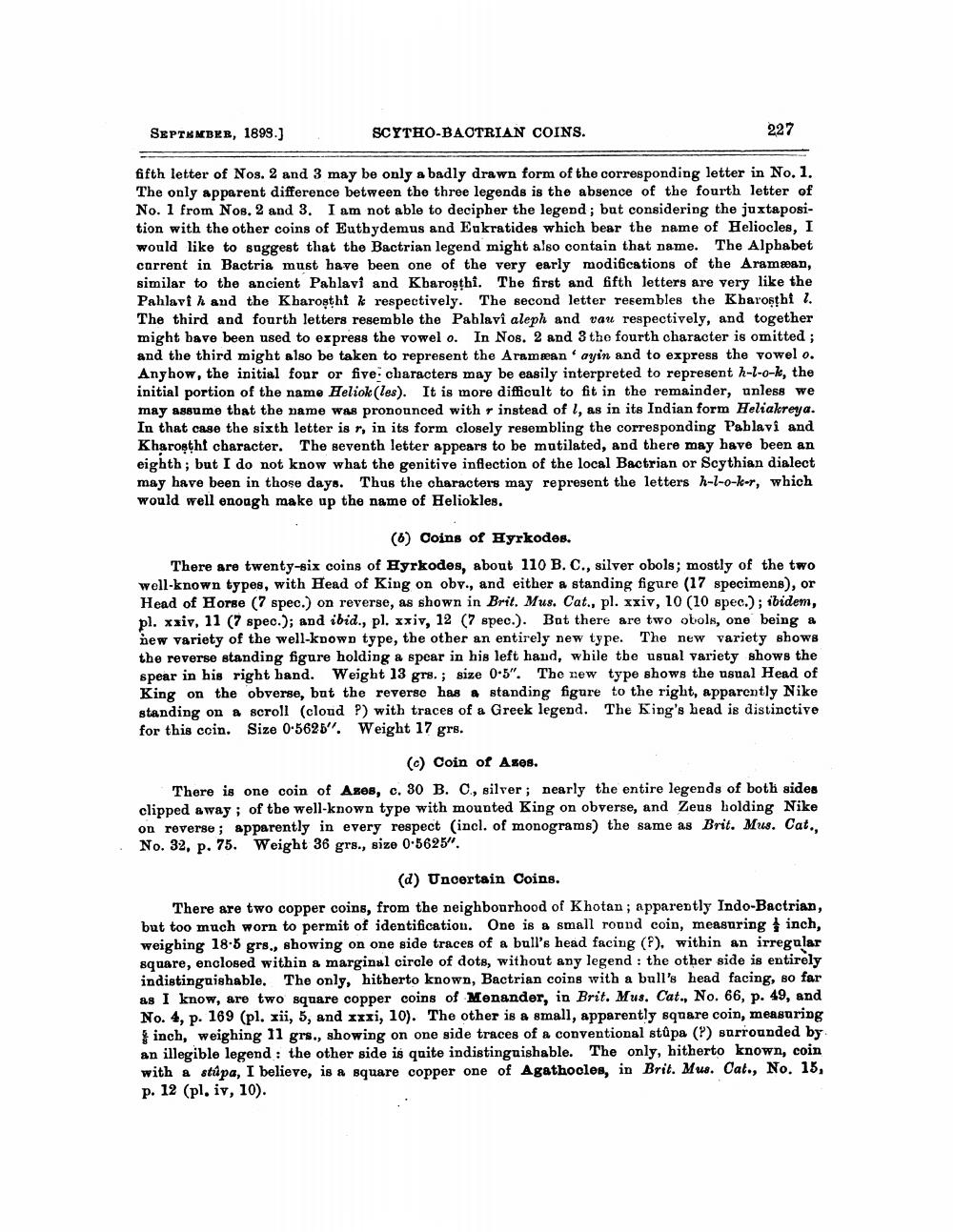________________
SEPTEMBER, 1899.)
SCYTHO-BAOTRIAN COINS.
227
Gifth letter of Nos. 2 and 3 may be only a badly drawn form of the corresponding letter in No. 1. The only apparent difference between the three legends is the absence of the fourth letter of No. 1 from Nos. 2 and 3. I am not able to decipher the legend; but considering the juxtaposition with the other coins of Euthydemus and Eukratides which bear the name of Heliocles, I would like to suggest that the Bactrian legend might also contain that name. The Alphabet carrent in Bactria must have been one of the very early modifications of the Aramaan, similar to the ancient Pablavi and Kbaroşthi. The first and fifth letters are very like the Pahlavi h and the Kharosthi k respectively. The second letter resembles the Kbaroshi l. The third and fourth letters resemble the Pablavi aleph and vau respectively, and together might have been used to express the vowel o. In Nos. 2 and 3 the fourth character is omitted ; and the third might also be taken to represent the Arameanayin and to express the vowel o. Anyhow, the initial four or five characters may be easily interpreted to represent h-l-o-k, the initial portion of the name Heliok (les). It is more difficult to fit in the remainder, unless we may assume that the name was pronounced with instead of l, as in its Indian form Heliakreya. In that case the sixth letter is r, in its form closely resembling the corresponding Pablavi and Kharoştht character. The seventh letter appears to be mutilated, and there may have been an eighth; but I do not know what the genitive inflection of the local Bactrian or Scythian dialect may have been in those days. Thus the characters may represent the letters h-l-o-ke-r, which would well enough make up the name of Heliokles.
(6) Coins of Hyrkodes. There are twenty-six coins of Eyrkodes, about 110 B. C., silver obols; mostly of the two well-known types, with Head of King on obv., and either a standing figure (17 specimens), or Head of Horse (7 spec.) on reverse, as shown in Brit. Mus. Cat., pl. xxiv, 10 (10 spec.); ibidem, pl. xxiv, 11 (7 spec.); and ibid., pl. xxiv, 12 (7 spec.). But there are two obols, one being a new variety of the well-known type, the other an entirely new type. The new variety shows the reverse standing figure holding a spear in his left hand, while the usual variety shows the spear in his right hand. Weight 13 grs. ; size 0.5". The new type shows the usual Head of King on the obverse, but the reverse has a standing figure to the right, apparently Nike standing on a scroll (cloud ?) with traces of a Greek legend. The King's head is distinctive for this coin. Size 0-5625". Weight 17 grs.
(c) Coin of Ases. There is one coin of Axes, c. 80 B. C., silver; nearly the entire legends of both sides clipped away ; of the well-known type with mounted King on obverse, and Zeus holding Nike
on reverse ; apparently in every respect (incl. of monograms) the same as Brit. Mus. Cat. • No. 32, p. 75. Weight 36 grs., size 0.5625".
(d) Uncertain Coins. There are two copper coins, from the neighbourhood of Khotan; apparently Indo-Bactrian, but too much worn to permit of identification. One is a small round coin, measuring inch, weighing 18.5 grs., showing on one side traces of a bull's head facing (f), within an irregular square, enclosed within a marginal circle of dots, without any legend : the other side is entirely indistinguishable. The only, hitherto known, Bactrian coins with a bull's head facing, so far as I know, are two square copper coins of Menander, in Brit. Mus. Cat., No. 66, p. 49, and No. 4, p. 169 (pl. xii, 5, and xxxi, 10). The other is a small, apparently square coin, measuring
inch, weighing 11 grs., showing on one side traces of a conventional stúpa (?) surrounded by an illegible legend : the other side is quite indistinguishable. The only, hitherto known, coin with a stúpa, I believe, is a square copper one of Agathocles, in Brit. Mus. Cat., No. 15, p. 12 (pl. iv, 10).




